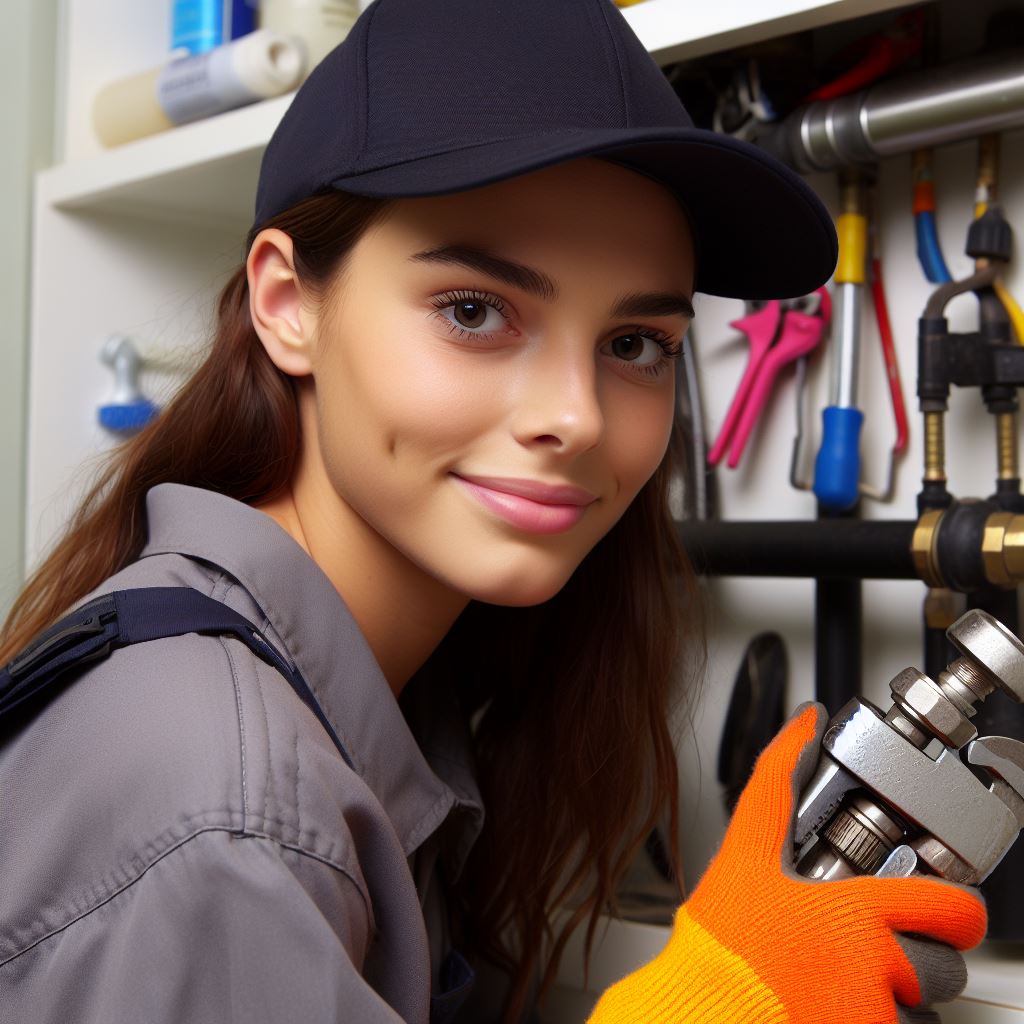Introduction
Green plumbing is a sustainable approach to plumbing that focuses on conserving resources and reducing environmental impact.
In Australia’s plumbing industry, eco-friendly solutions are crucial for a sustainable future.
This blog post will discuss the importance of green plumbing and highlight key points in Australia’s eco solutions.
Green Plumbing: Australia’s Eco Solutions
Green plumbing is an innovative and environmentally friendly way of approaching plumbing systems, making them more sustainable and efficient.
With rising concerns about climate change and the depletion of natural resources, the importance of eco-friendly solutions in Australia’s plumbing industry cannot be emphasized enough.
Firstly, green plumbing helps conserve valuable resources like water and energy.
By installing water-efficient fixtures, such as low-flow toilets and showerheads, households and businesses can significantly reduce water consumption and lower their utility bills.
Secondly, green plumbing minimizes pollution and reduces the carbon footprint.
Using sustainable materials and implementing water treatment systems can prevent water pollution and protect Australia’s natural ecosystems.
Thirdly, green plumbing promotes health and well-being.
Through eco solutions such as rainwater harvesting, greywater reuse, and water filtration systems, Australians can have access to clean and safe water, reducing the risk of waterborne diseases.
Moreover, green plumbing contributes to economic growth and job creation.
As the demand for sustainable plumbing solutions increases, more professionals with specialized skills will be needed, leading to the creation of green job opportunities in the plumbing industry.
In review, green plumbing is essential for Australia’s plumbing industry to mitigate environmental damage and ensure a sustainable future.
By implementing eco-friendly solutions, we can conserve resources, reduce pollution, promote health, and drive economic growth.
Stay tuned for more detailed discussions on specific eco solutions in upcoming blog posts.
Defining Green Plumbing
Green plumbing refers to plumbing practices that prioritize sustainability and the efficient use of water.
Its principles encompass various techniques and technologies aimed at reducing water consumption and minimizing environmental impact.
In conventional plumbing, excessive water usage is prevalent, leading to significant wastage and strain on water resources.
Green plumbing focuses on addressing these issues by implementing measures that promote water conservation and sustainable practices.
The concept and principles of green plumbing
One of the key concepts of green plumbing is the use of water-efficient fixtures and appliances.
- Low-flow toilets, faucets, and showerheads are examples of such fixtures that use less water without compromising functionality.
- These fixtures typically employ aerators, which add air to the water stream, thereby reducing water flow and consumption.
- Greywater systems are also used in green plumbing to maximize water reuse.
- These systems collect non-toilet wastewater, such as from showers and sinks, and treat it for reuse in activities like irrigation.
Another aspect of green plumbing is the implementation of rainwater harvesting systems.
- This involves collecting rainwater from roofs and storing it for later use, reducing reliance on mains water supply.
- The harvested rainwater can be used for various non-potable purposes, including toilet flushing and outdoor irrigation.
- This helps conserve water resources and reduces the strain on municipal water supply systems.
Furthermore, green plumbing emphasizes proper water management through leak detection and prevention.
- Leaky pipes and fixtures can waste significant amounts of water over time.
- By actively monitoring and promptly addressing leaks, green plumbing helps minimize water loss and damage to property.
- This contributes to water conservation efforts and reduces water bills for homeowners and businesses.
Reducing water consumption and promoting sustainability
In addition to water conservation, green plumbing also focuses on reducing energy consumption.
- Heating water accounts for a significant portion of household energy usage.
- Green plumbing tackles this issue by promoting the use of energy-efficient water heaters.
- Solar water heaters, for example, use renewable energy from the sun to heat water, reducing reliance on electricity or gas.
- Insulating hot water pipes and using heat trap fittings also help retain heat and minimize heat loss during distribution.
In essence, green plumbing is an essential aspect of promoting sustainable practices in Australia.
By prioritizing water conservation, implementing efficient fixtures, and reducing energy consumption, green plumbing helps protect the environment and reduce water and energy bills.
Its principles and techniques can be adopted by homeowners, businesses, and the plumbing industry to create a more sustainable future.
Benefits of Green Plumbing
Green plumbing solutions in Australia offer numerous advantages that go beyond just water conservation and reduced energy consumption.
By using eco-friendly materials and technologies in plumbing systems, we can significantly improve indoor air quality and promote better health for all.
Water Conservation and Reduced Energy Consumption
- Green plumbing systems incorporate water saving fixtures and technologies, leading to reduced water waste.
- Efficient fixtures such as low-flow toilets, showerheads, and faucets can save significant amounts of water.
- Smart water meters help track water usage, enabling homeowners to identify and resolve leaks promptly.
- Using energy-efficient appliances like tankless water heaters reduces energy consumption and utility bills.
Eco-Friendly Materials and Technologies
- Choosing eco-friendly materials like recycled pipes and fittings minimizes environmental impact.
- Water treatment systems, rainwater harvesting, and greywater recycling help decrease strain on water resources.
- Solar-powered water heaters and photovoltaic panels contribute to a greener and more sustainable future.
- Green plumbing also encourages the use of non-toxic, biodegradable cleaning products to minimize pollution.
Improved Indoor Air Quality
- Traditional plumbing systems can release harmful gases and chemicals into the air.
- Green plumbing eliminates the risk of indoor air pollution by using lead-free pipes and fixtures.
- Proper ventilation and backflow prevention systems promote better air quality inside homes and buildings.
- Reducing the use of chemical drain cleaners and opting for natural alternatives protects indoor air quality.
Health Benefits
- Green plumbing eliminates the risk of exposure to harmful substances like lead and asbestos.
- Using eco-friendly cleaning products reduces the chances of respiratory issues and skin irritations.
- Increased water efficiency prevents the growth of mold and mildew, reducing the risk of respiratory problems.
- By conserving water, green plumbing ensures the availability of clean and safe water for future generations.
In fact, green plumbing provides a range of benefits for homeowners, the environment, and society as a whole.
By adopting eco-friendly materials, water-saving technologies, and efficient appliances, we can conserve water, reduce energy consumption, improve indoor air quality, and promote better health.
It is crucial to embrace these sustainable plumbing solutions to create a greener and healthier future for Australia.
Your Personalized Career Strategy
Unlock your potential with tailored career consulting. Get clear, actionable steps designed for your success. Start now!
Get StartedRead: Carpentry 101: An Aussie’s Guide to the Trade
Examples of Eco Solutions in Australia
Green plumbing initiatives and projects in Australia
Australia has been at the forefront of implementing various green plumbing initiatives and projects. These eco solutions are aimed at conserving water, reducing energy consumption, and protecting the environment.
Through specific case studies and innovative practices, Australia showcases its commitment to sustainable plumbing.
Water-Efficient Fixtures and Appliances
One of the key eco solutions in Australia is the widespread installation of water-efficient fixtures and appliances.
These include low-flow toilets, water-saving showerheads, and aerated taps. Such fixtures help decrease water consumption while maintaining optimal functionality.
Case Study: The Sydney Olympic Park
The Sydney Olympic Park serves as a remarkable example of successful eco solutions implementation.
The park has integrated rainwater harvesting systems, which collect and store rain for reuse in irrigation and toilet flushing. This resulted in a significant reduction in freshwater consumption.
Innovative Wastewater Treatment Systems
Australia has also developed innovative wastewater treatment systems that minimize water wastage and pollution.
One such system is the use of greywater for irrigation purposes. Greywater, which includes water from showers, baths, and laundry, is treated and reused in gardens, reducing dependency on freshwater resources.
Case Study: The City of Melbourne
The City of Melbourne has implemented a centralized wastewater treatment plant, capable of treating 140 million liters of sewage daily.
The treated water is then used for non-potable purposes like toilet flushing, irrigation, and industrial processes. This solution has resulted in reduced strain on freshwater resources.
Rainwater Harvesting Practices
Rainwater harvesting is a widely adopted practice in Australia to conserve water and minimize stormwater runoff.
Many residential and commercial buildings have installed rainwater tanks to collect and store rainwater for various purposes. This practice not only reduces water consumption but also helps prevent flooding.
Case Study: Adelaide’s Stormwater Management Program
Adelaide’s Stormwater Management Program emphasizes the importance of rainwater harvesting.
The program encourages residents and businesses to capture and reuse rainwater through various initiatives, such as rebates and educational campaigns.
This has led to a significant decrease in stormwater runoff and increased water conservation.
Australia’s eco solutions in the plumbing sector demonstrate the country’s commitment to environmental sustainability.
Australia conserves water and reduces environmental impact by installing water-efficient fixtures, pioneering wastewater treatment systems, and practicing rainwater harvesting.
These initiatives serve as inspiration for other countries to adopt similar eco-friendly plumbing practices.
Together, we can create a greener future for our planet.
Read: Plumbing Maintenance Tips for Aussie Homes
Discover More: Underwater Welding in Australia: Opportunities
Government Regulations and Incentives
When it comes to promoting green plumbing practices, the Australian government has implemented various regulations and incentives.
These measures aim to encourage individuals, businesses, and communities to adopt eco-friendly plumbing solutions for a more sustainable future.
Government Regulations
The government has put several regulations in place to promote green plumbing practices throughout the country.
These regulations ensure that eco plumbing solutions are not just an option but a requirement for new construction and renovation projects.
Building codes and regulations play a crucial role in promoting eco-friendly plumbing practices in Australia.
These codes outline the minimum standards and requirements for sustainable water management systems, rainwater harvesting, greywater reuse, and wastewater treatment.
By incorporating these codes into their designs and installations, plumbers, architects, and builders contribute to reducing water consumption, promoting water conservation, and protecting the environment.
Financial Incentives and Rebates
In addition to regulations, the Australian government offers various financial incentives and rebates to further encourage the adoption of green plumbing practices.
One such incentive is the Green Loans program, which provides interest-free loans of up to $10,000 to homeowners for implementing energy-efficient and water-saving measures, including eco plumbing systems.
This program not only helps homeowners save money in the long run but also reduces their environmental impact.
The government also offers rebates for the installation of water-efficient appliances and fixtures, such as low-flow toilets, showerheads, and faucets.
These rebates help offset the cost of purchasing and installing eco plumbing solutions, making them more accessible for homeowners and businesses.
Stand Out with a Resume That Gets Results
Your career is worth more than a generic template. Let us craft a resume and cover letter that showcase your unique strengths and help you secure that dream job.
Get HiredCertifications and Standards
To ensure the quality and reliability of eco plumbing systems, various certifications and standards have been established in Australia.
The Water Efficiency Labelling and Standards (WELS) scheme is one such certification program.
It provides a rating system for water-efficient products, helping consumers make informed decisions about their plumbing fixtures and appliances.
By choosing products with higher WELS ratings, individuals can minimize their water consumption and contribute to water conservation efforts.
Furthermore, the Plumbing Code of Australia (PCA) sets the standards for plumbing practices across the country.
It incorporates provisions for eco plumbing systems and encourages sustainable water management practices.
Plumbers and professionals in the plumbing industry must adhere to these certifications and standards to ensure that their installations meet the required environmental performance criteria.
The Australian government plays a vital role in promoting green plumbing practices through its regulations, incentives, and standards.
By implementing eco-friendly plumbing solutions, individuals and businesses can contribute to water conservation, reduce their environmental impact, and create a more sustainable future.
Read: DIY Plumbing: What Aussies Should Know

You Might Also Like: Designing Drought-Tolerant Aussie Gardens
Challenges and Future Outlook
Identification of challenges
Implementing green plumbing practices in Australia comes with its fair share of challenges.
Identifying these challenges is crucial to finding effective solutions and ensuring a sustainable future for eco-friendly plumbing.
One of the main obstacles is the affordability factor.
Green plumbing technologies, although beneficial in the long run, often require a higher upfront investment.
This can deter many homeowners and businesses from embracing these practices.
To overcome this challenge, it is essential to educate consumers about the long-term cost savings and environmental benefits of green plumbing.
Affordability factor and the need for education and awareness
Education and awareness play a significant role in promoting the adoption of eco-friendly plumbing solutions.
Many people are not familiar with the concept of green plumbing or the available eco-friendly products and methods.
Therefore, providing information and creating awareness campaigns are crucial steps towards widespread acceptance and implementation.
Another challenge is the resistance from traditional plumbing practices.
Plumbers who are familiar with conventional methods may be hesitant to embrace new technologies and techniques.
It is important to provide training programs and incentives to encourage plumbers to upgrade their skills and adopt green plumbing practices.
Future trends and advancements in eco plumbing technology
Despite these challenges, the future outlook for green plumbing in Australia is promising.
As the demand for sustainable solutions grows, advancements in eco plumbing technology are expected.
Innovations such as smart water meters, greywater recycling systems, and high-efficiency fixtures are revolutionizing the plumbing industry.
These advancements not only save water but also reduce energy consumption, contributing to a greener environment.
For instance, smart water meters allow individuals to monitor their water usage in real-time and make necessary adjustments to conserve water.
Continuous efforts required to promote eco-friendly plumbing solutions
Furthermore, the continuous efforts of government bodies, environmental organizations, and industry professionals are crucial in promoting green plumbing.
It is important to establish standards and regulations that support eco-friendly practices and incentivize their implementation.
Additionally, initiatives like green building certifications and eco-labeling programs can raise awareness and encourage the adoption of sustainable plumbing practices.
These certifications help consumers identify eco-friendly products and services, making it easier for them to make environmentally conscious choices.
In general, while there are challenges in implementing green plumbing practices in Australia, the future outlook is promising.
Education, awareness, and the development of technology are vital components in overcoming these challenges and ensuring a sustainable future.
Continuous efforts and collaborations between various stakeholders are essential in promoting eco-friendly plumbing solutions and creating a greener Australia.
Read: Costs of Plumbing Services in Australia
Conclusion
In closing, this blog post has delved into the key facets of Australia’s pioneering efforts in green plumbing, encapsulating a comprehensive overview of its core components.
From the installation of water-efficient fixtures to the innovative implementation of wastewater treatment systems and the incorporation of rainwater harvesting practices, the nation has emerged as a leader in sustainable water resource management.
The significance of green plumbing in the Australian context cannot be overstated.
As we have explored, it is not merely a series of isolated practices but a holistic approach to environmental conservation.
Through this lens, the reinforcement of the importance of green plumbing takes center stage.
It serves as a linchpin for water conservation initiatives and plays a pivotal role in mitigating the environmental impact associated with traditional plumbing systems.
In urging individuals and businesses to embrace eco-friendly plumbing practices, we underscore the role each stakeholder can play in fostering a collective commitment to sustainability.
Whether it be the conscientious homeowner or the forward-thinking business owner, the adoption of green plumbing practices is a tangible and impactful contribution towards a more sustainable future.
As we reflect on the potential positive impact of widespread adoption of green plumbing solutions in Australia, a vision of a greener, more ecologically balanced future emerges.
It is a future where water resources are conserved, ecosystems are safeguarded, and communities thrive in harmony with their surroundings.
The transformative power of embracing these sustainable plumbing solutions is not just limited to individual households or businesses; it extends to a nationwide shift towards a more environmentally conscious paradigm.
In the end, let us collectively recognize the pivotal role of green plumbing in shaping the trajectory of Australia’s environmental stewardship.
Championing these practices establishes a foundation for a sustainable future. The positive impact resonates across communities, industries, and natural landscapes, defining a diverse, vibrant nation.




